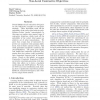Free Online Productivity Tools
i2Speak
i2Symbol
i2OCR
iTex2Img
iWeb2Print
iWeb2Shot
i2Type
iPdf2Split
iPdf2Merge
i2Bopomofo
i2Arabic
i2Style
i2Image
i2PDF
iLatex2Rtf
Sci2ools
ICML
2010
IEEE
2010
IEEE
Non-Local Contrastive Objectives
Pseudo-likelihood and contrastive divergence are two well-known examples of contrastive methods. These algorithms trade off the probability of the correct label with the probabilities of other "nearby" instantiations. In this paper we explore more general types of contrastive objectives, which trade off the probability of the correct label against an arbitrary set of other instantiations. We prove that a large class of contrastive objectives are consistent with maximum likelihood, even for finite amounts of data. This result generalizes asymptotic consistency for pseudo-likelihood. The proof gives significant insight into contrastive objectives, suggesting that they enforce (soft) probabilityratio constraints between pairs of instantiations. Based on this insight, we propose Contrastive Constraint Generation (CCG), an iterative constraint-generation style algorithm that allows us to learn a log-linear model using only MAP inference. We evaluate CCG on a scene classification ...
Contrastive Divergence | Contrastive Methods | Contrastive Objectives | ICML 2010 | Machine Learning |
| Added | 09 Nov 2010 |
| Updated | 09 Nov 2010 |
| Type | Conference |
| Year | 2010 |
| Where | ICML |
| Authors | David Vickrey, Cliff Chiung-Yu Lin, Daphne Koller |
Comments (0)

